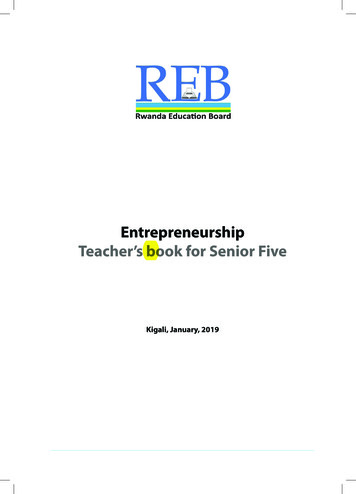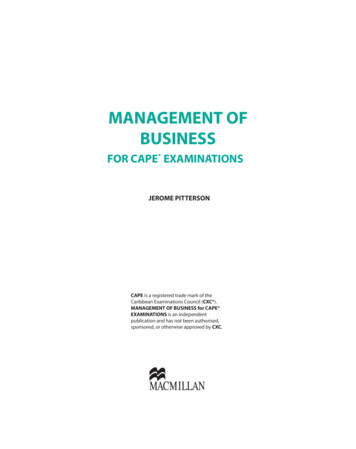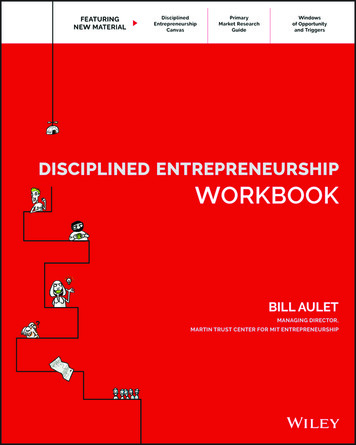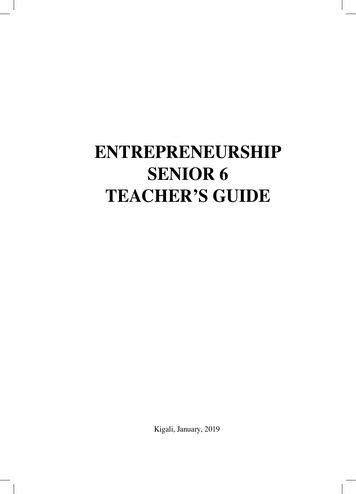
Transcription
EntrepreneurshipTeacher’s book for Senior FiveKigali, January, 2019
Copyright 2019 Rwanda Education BoardAll rights reserved.This document is the property of Rwanda Education Board.Credit should be given to REB when the source of this Teacher’s guide is quotedTeachers’ Guide
FOREWORDDear teacher,Rwanda Education Board is honoured to present Senior 5 entrepreneurship teacher sguide which serves as a guide to competence-based teaching and learning to ensureconsistency and coherence in the learning of the entrepreneurship subject. TheRwandan educational philosophy is to ensure that learners achieve full potential atevery level of education which will prepare them to be well integrated in society andexploit employment opportunities.In line with efforts to improve the quality of education, the government of Rwandaemphasizes the importance of aligning teaching and learning materials with the syllabusto facilitate their learning process. Many factors influence what they learn, how wellthey learn and the competences they acquire. Those factors include the relevance ofthe specific content, the quality of teachers’ pedagogical approaches, the assessmentstrategies and the instructional materials available. We paid special attention to theactivities that facilitate the learning process in which learners can develop ideas andmake new discoveries during concrete activities carried out individually or with peers.With the help of the teachers, learners will gain appropriate skills and be able to applywhat they have learnt in real life situations. Hence, they will be able to develop certainvalues and attitudes allowing them to make a difference not only to their own life butalso to the nation.This is in contrast to traditional learning theories which view learning mainly as a processof acquiring knowledge from the more knowledgeable who is mostly the teacher. Incompetence-based curriculum, learning is considered as a process of active buildingand developing of knowledge and understanding, skills and values and attitude by thelearner where concepts are mainly introduced by an activity, situation or scenario thathelps the learner to construct knowledge, develop skills and acquire positive attitudesand values.In addition, such active learning engages learners in doing things and thinking aboutthe things they are doing and they are encouraged to bring their own real experiencesand knowledge into the learning processes. In view of this, your role is to: Plan your lessons and prepare appropriate teaching materials. Organize group discussions for learners considering the importance ofsocial constructivism suggesting that learning occurs more effectivelywhen the learner works collaboratively with more knowledgeable andexperienced people. Engage learners through active learning methods such as inquiry methods,group discussions, research, investigative activities and group andindividual work activities.Teachers’ Guidei
Provide supervised opportunities for learners to develop differentcompetences by giving tasks which enhance critical thinking, problemsolving, research, creativity and innovation, communication andcooperation. Support and facilitate the learning process by valuing learners’ contributionsin the class activities. Guide learners towards the harmonization of their findings. Encourage individual, peer and group evaluation of the work done in theclassroom and use appropriate competence-based assessment approachesand methods.To facilitate you in your teaching activities, the content of this teacher s guide is selfexplanatory so that you can easily use it. It is divided in 3 parts:The part 1:guidance;Explains the structure of this book and gives you the methodologicalThe part 2:process;Gives the sample lesson plans as reference for your lesson planningThe part 3:Provides details the teaching guidance for each concept given in thestudent book.Even though this teacher s guide contains the answers for all activities given in thelearner’s book, you are requested to work through each question and activity beforejudging learner’s findings.I wish to sincerely appreciate all people who contributed towards the development ofthis teacher s guide, particularly REB staff who organized the whole process from itsinception. Special gratitude goes to the University of Rwanda which provided expertsin design and layout services, illustrations and image anti-plagiarism, lecturers andteachers who diligently worked to successful completion of this book. Any commentor contribution would be welcome for the improvement of this textbook for the nextedition.Dr. NDAYAMBAJE IrénéeDirector General of REBiiTeachers’ Guide
ACKNOWLEDGEMENTI wish to express my appreciation to all the people who played a major role indevelopment of this Entrepreneurship Teacher s Guide for senior five. It would nothave been successful without active participation of different education stakeholders.I owe gratitude to different Universities and schools in Rwanda that allowed their staffto work with REB in the in-house textbooks production project. I wish to extend mysincere gratitude to lecturers, teachers and all other individuals whose efforts in oneway or the other contributed to the success of writing of this textbook.Special acknowledgement goes to the University of Rwanda which provided experts indesign and layout services, illustrations and image anti-plagiarism.Finally, my word of gratitude goes to the Rwanda Education Board staff particularlythose from the departmentJoan Murungi,Head of CTLRTeachers’ Guideiii
CONTENTSFOREWORDiACKNOWLEDGEMENTiiPART I. GENERAL INTRODUCTIONviii1.1. The structure of the guideviii1.2. Methodological guidancexPART II: SAMPLE LESSON PLANSxxviiPART III: UNIT DEVELOPMENTxxxiiiUNIT 1: BUSINESS IDEAS AND OPPORTUNITIES11.2. Cross-cutting issues to be addressed11.1 Unit Prerequisite11.3. Generic competencies21.4. List of lessons (including assessment)41.5 Use of skills lab method: Skills Lab 1221.6 Unit Summary251.7. Additional Information251.8. End of unit 1 assessment261.9. Additional Activities28UNIT 2: CONTRACTS IN BUSINESS OPERATIONS312.2. Cross-cutting issues to be addressed312.1 Unit Prerequisite312.3. Generic competencies322.4. List of lessons (including assessment)352.5 Use of Skills Lab Method: Skills Lab 2622.6. Summary of the unit632.7. Additional information722.8. End of Unit 2 Assessment752.9. Additional activities77UNIT 3: TAXES IN BUSINESS793.2 Cross-cutting issues to be addressed793.1. Unit Prerequisite793.3 Generic competences to be developed803.4 List of lessons (including assessment)833.5 Use of skills lab method: Skills Lab 3iv108Teachers’ Guide
3.6. Summary of the unit1113.7 Additional information1113.8. End unit Assessment112UNIT 4 : RESEARCH IN BUSINESS1174.2 Cross-cutting issues to be addressed:1174.1 Unit Prerequisite1174.3 Generic competencies:1184.4 Summary of the unit1434.7 Additional information1444.8 Additional Activities1454.9 End Unit 4 Assessment147UNIT 5: BUSINESS GROWTH AND DEVELOPMENT1535.2. Cross-cutting issues to be addressed1535.1. Unit Prerequisite1535.3. Generic competences to be developed1545.4. List of lessons1575.5.Use of skills lab method: Skills Lab1755.6 Unit Summary1775.7. Additional information1785.8. End unit 5 assessment1795.9. Additional activities180UNIT 6:TECHNOLOGY IN BUSINESS OPERATIONS1816.2. Crosscutting issues to be addressed1816.1. Unit Pre-requisite1816.3. Generic competencies1826.4. Lists of lessons.1866.5. Use of Skills Lab Method: Skills Lab 62136.6. End of unit summary2156.7. Additional information:2166.8. End of Unit 6 Assessment2176.9. Additional Activities225UNIT 7: INTERPERSONAL2277.2 Cross-cutting issues to be addressed2277.1 Unit Prerequisite2277.3. Generic competences to be developed228Teachers’ Guidev
7.4 List of lessons (including assessment)2337.5. Use of skills lab method: Skills Lab 72587.6. Unit Summary2617.7 Additional information2627.8. End unit 7 assessment2637.9. Additional activities269UNIT 8: OFFICE PROCEDURES2718.2. Cross-cutting issues to be addressed2718.1 Unit Prerequisite2718.3. Generic competencies2728.4. List of lessons (including assessment)2748.6. Unit Summary:2978.7. Additional information:3008.8. End of Unit 8 Assessment3018.9. Additional Activities312UNIT 9: MONEY MANAGEMENT3159.2. Cross-cutting issues to be addressed3151.1 Unit Prerequisite3159.3. Generic competencies316 9.4. List of lessons (including assessment)3199.5 Use of skills lab method: Skills Lab 93459.6. Unit Summary3489.7. Additional Information3489.8. End of Unit 9 Assessment3499.9. Additional Activities352UNIT 10: ACCOUNTING PRIME BOOKS35310.2 Crosscutting issues to be addressed35310.1 Unit Prerequisite35310.3 Generic competencies35510.4 Guidance on the introductory activity35810.7 Additional information for teachers40210.8 End of unit 10 assessment answers: Refer to S.B 10.840310.9 Additional activities410UNIT 11 : RIGHTS AND RESPONSABILITIES OF WORKERS AND EMPLOYERS 41911.2. Cross-cutting issues to be addressedvi419Teachers’ Guide
11.1. Unit Prerequisite41911.3. Generic competencies:42011.5. Use of skills lab method: Skills Lab 1143111.6. Summary of the unit43311.7. Additional information for teachers43311.8. End of Unit 11 Assessment43411.9. Additional activities435UNIT 12 TEAM LEADERSHIP43712.1 Key Unit Competency:43712.2 Crosscutting issues to be addressed43712.1. Unit Prerequisite43712.3 Generic competencies43912.4 Guidance on Introductory activity44112.5 List of lessons (including assessment)44212.5 Use of Skills Lab Method:Skills Lab 1247812.6 Unit Summary48012.7 Additional Information48112.8 Additional activities48212.9 Unit 12 Assessment484UNIT 13:CONFORMITY ASSESSMENT IN BUSINESS49513.2 Crosscutting issues to address49513.1. Unit Prerequisite49513.3 Generic competencies to be developed49613.4 List of lessons (including assessment)50012.6 Use of Skills Lab Method: Skills Lab 1352213.5 Summary of the unit52413.7 End of Unit 13 Assessment52813.8 Additional activities530BIBLIOGRAPHY533ANNEXES536:Teachers’ Guidevii
PRESENTATION OF THE TEACHER S GUIDEPART I. GENERAL INTRODUCTIONIntroductionThe purpose of this teacher’s guide is to help you implement the entrepreneurshipsyllabus. It is designed to stimulate you to create exciting and meaningful lessons byenabling you to choose relevant and purposeful activities and teaching strategies. Itwill encourage you to research and look for new and challenging ways of facilitatingstudents’ learning. The teacher guide and the syllabus must be used side by side. Thesyllabus states the learning outcomes for the subject and each unit, and outlines thecontent and skills that students will learn, and the assessment requirements.The teacher’s guide provides direction for you in using the outcomes approach in yourclassroom using a step by step approach. This teacher’s guide provides examples ofteaching and learning strategies for entrepreneurship, elaboration of suggestedactivities and content, detailed information on how to mark assessment tasks and theresources needed to teach entrepreneurship.1.1. The structure of the guideThis section presents the overall structure, the unit and sub-heading structure to helpteachers to understand the different sections of this guide and what they will find ineach section.Overall structureThe whole guide has three main parts as follows:Part I: General Introduction.This part provides general guidance on how to develop the generic competences, howto integrate cross cutting issues, how to cater for learners with special educationalneeds, active methods and techniques of teaching entrepreneurship and guidance onassessment.Part II: Sample lesson planThis part provides a sample lesson plan developed and designed to help the teacherdevelop their own lesson plans.Part III: Unit developmentThis is the core part of this teacher s guide. Each unit is developed following thestructure below. The guide ends with references.viiiTeachers’ Guide
Structure of a unitEach unit is made of the following sections: Unit title: From the syllabus Key unit competence: From the syllabus Prerequisites (knowledge, skills, attitudes and values)This section indicates knowledge, skills and attitudes required for the success of theunit. The competence-based approach calls for connections between units/topicswithin a subject and interconnections between different subjects. The teacher will findan indication of those prerequisites and guidance on how to establish connections.Cross-cutting issues to be addressedThis section suggests cross-cutting issues that can be integrated depending on the unitcontent. It provides guidance on how to come up with the integration of the issue.Note that the issue indicated is a suggestion; teachers are free to take another crosscutting issue taking into consideration the learning environment.Guidance on the introductory activity:Each unit starts with an introductory activity in the learner’s book. This section of theteacher’s guide provides guidance on how to conduct this activity and related answers.Note that learners may not be able to find the right solution but they are invited topredict possible solutions or answers. Solutions are provided by learners graduallythrough discovery activities organized at the beginning of lessons or during the lesson.List of lessons/sub-headingThis section presents in a table suggestion on the list of lessons, lesson objectives copiedor adapted from the syllabus and duration for each lesson. Each lesson /subheadingis then developed.End of each unitAt the end of each unit the teacher’s guide provides the following sections:Summary of the unit which provides the key points of content developed in thestudent’s book.Additional information which provides additional content compared to the student’sbook for the teacher to have a deeper understanding of the topic.End unit assessment which provides the answers to questions of end unit assessmentin the textbook and suggests additional questions and related answers to assess theTeachers’ Guideix
key unit competence.Additional activities: remedial, consolidation and extended activities. Thepurpose of these activities is to accommodate each learner (slow, averageand gifted) based on end unit assessment results.-Structure of each-sub headingEach lesson/sub-heading is made of the following sections: Lesson /Sub-heading title Prerequisites/Revision/Introduction:This section gives a clear instruction to teacher on how to start the lesson-Teaching resources: This section suggests the teaching aids or otherresources needed in line with the activities to achieve the learning objectives.Teachers are encouraged to replace the suggested teaching aids by the onesavailable in their respective schools and based on learning environment.-Learning activities: This section provides a short description of themethodology and any important aspect to consider. It provides also answersto learning activities with cross reference to text book:-Exercises/application activities:This provides questions and answersfor exercises/ application activities1.2. Methodological guidance1.2.1. Developing competencesSince 2015, Rwanda shifted from a knowledge based to a competency basedcurriculum for pre-primary, primary and general secondary education. Thiscalled for changing the way of learning by shifting from teacher centered to alearner-centered approach. Teachers are not only responsible for knowledgetransfer but also for fostering children’s learning achievement, and creatingsafe and supportive learning environment. It implies also that a learner has todemonstrate what he/she is able to do using the knowledge, skills, values andattitude acquired in a new or different or given situation.The competence-based curriculum employs an approach of teaching andlearning based on discrete skills rather than dwelling on only knowledge orthe cognitive domain of learning. It focuses on what learner can do rather thanwhat learners know. Learners develop basic competences through specificsubject unit competences with specific learning objectives broken down intoknowledge, skills and attitudes. These competences are developed throughxTeachers’ Guide
learning activities disseminated in learner-centered rather than the traditional didacticapproach. The student is evaluated against set standards to achieve before moving on.In addition to specific subject competences, learners also develop generic competenceswhich are transferable throughout a range of learning areas and situations in life.Below are example of how generic competences can be developed in the subject ofEntrepreneurship Critical Thinking: Learners analyze their environment or communityfor problems or challenges faced and the causes. After, they suggest possibleremedies to the identified problem during generation of business ideas andopportunities. Research and problem solving: Learners collect data using interviews,questionnaires and any other tool, analyze the data gathered and suggestsolutions regarding business customer behavior in a research in business unit. Creativity and Innovation: Learners analyse resources such wastematerials existing in the community or environment. They develop or come upwith new ways of utilizing such resources or how they can be put to use again ingenerating business ideas and opportunities Communication Skills: Learners can present themselves and their abilitiesby writing application letters or CVs to potential employers. Can write differentdocuments such Memos, Notices in a clear and understandable language toconvey on information effectively during interpersonal communication ement and life skills: Learners in teams complete different taskswhere each may take on a different role while complementing each other’sstrengths and weaknesses in team leadership. Alternatively, teams compete toprepare and present a business plan for their team projects to potential investorsor financial institutions. Lifelong Learning:Learners lead a problem solving and decision makingprocess in a team. Does a self-evaluation to identify own areas of strengths,areas of weaknesses and propose strategies for enhancing and improving in ateam leadership. Alternatively, learners analyse a scenario involving conflicts ata workplace, identify the causes, suggest solutions and propose how they willapply the learned lessons to similar situations in real situations1.2.2. Addressing cross-cutting issuesTeachers’ Guidexi
Among the changes in the competence-based curriculum is the integration of crosscutting issues as an integral part of the teaching learning process-as they relate to andmust be considered within all subjects to be appropriately addressed. There are eightcross cutting issues identified in the national curriculum framework. (See annex 2).Some cross-cutting issues may seem specific to particular learning areas/subjects butthe teacher need to address all of them whenever an opportunity arises. In addition,learners should always be given an opportunity during the learning process to addressthese crosscutting issues both within and out of the classroom.Below are examples on how crosscutting issues can be addressed in your subject: Gender education: Remind learners that both males and females havesimilar opportunities, rights and obligations in the workplace, and thereforeneed to be treated fairly and equally when dealing with contracts or resolvingconflicts. People’s opinion of gender roles should not deny or hinder one’s rightor responsibilities to meet his or her contractual obligations while teachingcontracts in business operations. Environment and sustainability: During generation of business ideas andopportunities, learners need to acknowledge that the greatest source of businessideas and opportunities is the environment, and one cannot implement his/heropportunity into a profitable business without the environment. So, throughoutthe unit/lesson have appreciate the need to take great care for environment as itis paramount for continued business ideas and opportunity generation as well assurvival of the business activities. Inclusive education: Learners all need to realize that universal laws donot discriminate as they to apply to all regardless of social, economic, political,physical background. Emphasis in this unit should be on how we all have the samerights. During rights and responsibilities of workers and employers unit, learnersmay discuss and appreciate need to respect and advocate for employer’s andworker’s rights and responsibilities at workplace. Peace and Values: Right before the lesson begins; there are quite a lot ofopportunities for teachers to promote peace and values among learners. Beingpunctual for activities (time management), involvement in various activities(teamwork), keeping their school environment clean (responsibility), greetingone another are among such opportunities (empathy). In a lesson the encouragelearners to greet one another, create a conducive learning environment, cleanthe chalkboard, arrange the classroom, assist one another with pens, books, classwork, among others. Also in case of conflicts within a lesson, take time to addressthe conflicts and discuss with learners the need to resolve conflicts amicably. Youmay also give learners an opportunity to participate in conflict resolution andxiiTeachers’ Guide
decision making. Comprehensive sexuality education (HIV/AIDS, STI, Familyplanning, Gender equality and reproductive health): During thelessons/activities, learners should be given an opportunity to discuss freely aboutthe various changes they are undergoing, as they are adolescents. They should beaware of how to manage the changes in their bodies, discuss HIV/AIDS withoutstigmatization, STIs and how to control them, family planning gender equalityand reproductive health. Learners should be encouraged to seek for appropriatehelp whenever needed. This may not directly fit or come in the lessons but utilizeopportunities observed among the learners both in and outside of the class. Financial Education: For example in setting personal goals, learners maybe requested to make a plan of what they plan to save, how much and when theyplan to achieve their saving goals. Learners may describe strategies to reducespending and increase savings to become financially fit. In every lesson, learnerscan share briefly their progress towards their goals: how much, strategies thatworked and what needs to improve on. While looking at financial managementand institutions, learners need to appreciate the need for managing their financesand proper ways of managing their finances such as opening a bank accountamong others. Standardization Culture: In every lesson take an opportunity to sharewith learners that standards should be respected since they are part and parcelof our lives. From school uniform, to class size, to lesson duration, languageof instruction, among others. So always, create opportunities to have learnersdiscuss where standards apply and when they need to be cautious aboutstandards during their everyday and business activities. Entrepreneurs requirestandards to be able to generate ideas, create opportunities, gather resources,start and operate businesses successfully. Genocide Studies:Learners need to become aware that all human beings areequal and have equal rights. At the work place they should avoid and denounce allinstances that result into other’s rights being violated. Give learners opportunitiesto share how an entrepreneur can promote the fight against genocide ideologiesduring generating ideas, creating opportunities, gathering resources, startingand operating businesses successfully. During rights and responsibilities session,learners relate the genocide of 1994 against the Tutsi and violation of humanrights.1.2.3 Attention to special educational needs and inclusive educationIn the classroom, learners learn in different way depending to their learning pace,needs or any other special problem they might have. However, a teacher has theTeachers’ Guidexiii
responsibility to know how to adopt his/her methodologies and approaches in orderto meet the learning need of each student in the classroom. Also teachers need tounderstand that learners with special needs; need to be taught differently or need someaccommodations to enhance the learning environment. This will be done depending tothe unit and the nature of the lesson.In order to create a well-rounded learning atmosphere, teachers need to: Remember that learners learn in different ways so they have to offer avariety of activities (e.g. role-play, music and singing, word games andquizzes, and outdoor activities) Maintain an organized classroom and limits distraction. This will helplearners with special needs to stay on track during lesson and followinstruction easily. Vary the pace of teaching to meet the needs of each learner. Somelearners process information and learn more slowly than others. Break down instructions into smaller, manageable tasks. Learners withspecial needs often have difficulty understanding long-winded or severalinstructions at once. It is better to use simple, concrete sentences in orderto facilitate them understand what you are asking. Use clear consistent language to explain the meaning (and demonstrate orshow pictures) if you introduce new words or concepts. Make full use of facial expressions, gestures and body language. Pair a learner who has a disability with a friend. Let them do things togetherand learn from each other. Make sure the friend is not over protective anddoes not do everything. Both learners will benefit from this strategy Use multi-sensory strategies. As all learners learn in different ways, it isimportant to make every lesson as multi-sensory as possible. Learners withlearning disabilities might have difficulty in one area, while they might excelin another. For example, use both visual and auditory cues.Below are general strategies related to each main category of disabilities and howto deal with every situation that may arise in the classroom. However, the list is notexhaustive because each learner is unique with different needs and that should behandled differently.Strategy to help a learner with developmental impairment: Use simple words and sentences when giving instructions.xivTeachers’ Guide
Use real objects that the learner can feel and handle. Rather than justworking abstractly with pen and paper. Break a task down into small steps or learning objectives. The learnershould start with an activity that s/he can do already before moving on tosomething that is more difficult. Gradually give the learner less help. Let the learner work in the same group with those without disability.Strategy to help a learner with visual impairment: Help learners to use their other senses (hearing, touch, smell and taste)to play and carry out activities that will promote their learning anddevelopment. Use simple, clear and consistent language. Use tactile objects to help explain a concept. If the learner has some sight difficulties, ask them what they can see. Make sure the learner has a group of friends who are helpful and who allowthe child to be as independent as possible. Plan activities so that learners work in pairs or groups whenever possibleStrategy to help a learner with hearing impairment: Always get the learner‘s attention before you begin to speak. Encourage the learner to look at your face. Use gestures, body language and facial expressions. Use pictures and objects as much as possible. Keep background noise to a minimum.Strategies to help learners with physical disabilities or mobilitydifficulties: Adapt activities so that learners who use wheelchairs or other mobility aidscan participate. Ask parents/caregivers to assist with adapting furniture e.g. The height ofa table may need to be changed to make it easier for a learner to reach it orTeachers’ Guidexv
fit their legs or wheelchair under. Encourage peer support Get advice from parents or a health professional about assistive devicesAdaptation of assessment strategiesEach unit in the teacher’s guide provides additional activities to help learners achievethe key unit competence. Results from assessment inform the teacher which learnerneeds remedial, consolidation or extension activities. These activities are designedto cater for the needs of all categories of learners; slow, average and gifted learnersrespectively.1.2.4. Guidance on assessmentAssessment is an ongoing process of identifying, gathering and interpreting informationabout students’ achievement of the learning outcomes and can be integrated into thestudents’ normal learning activities. Assessment is an important part of teaching andlearning. It is used to: Evaluate and improve teaching and learning Report achievement Provide feedback to students on their progress.Types of Assessment Assessment for learning (Continuous/ formative assessment): Assessmentfor learning is often called formative assessment and is assessment that gathersdata and evidence about student learning during the learning process. It enablesyou to see where students are having problems and to give immediate feedback,which will help your students learn better. It also helps you plan your lessons tomake student learning, and your teaching more effective. Often it is informal andstudents can mark their own work or their friends. An example is a quick classquiz to see if students remember the important points of the previous lesson. Assessment of learning (Summative assessment): Assessment of learning isoften called summative assessment. It is used to obtain evidence and data thatshows how much learning has occurred, usually at the end of the term or unit.End of year examinations are example
UNIT 10: ACCOUNTING PRIME BOOKS 353. 10.2 Crosscutting issues to be addressed 353 10.1 Unit Prerequisite 353 10.3 Generic competencies 355 10.4 Guidance on the introductory activity 358 . The purpose of this teacher's guide is to help you implement the entrepreneurship syllabus. It is designed to stimulate you to create exciting and .











